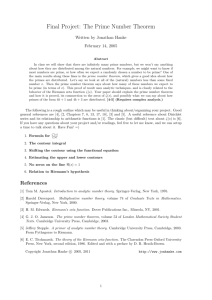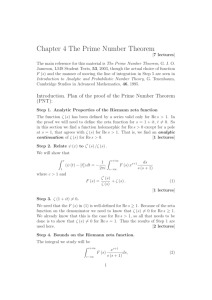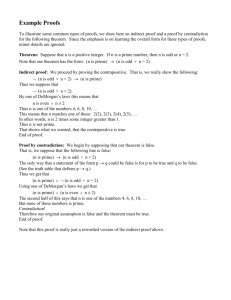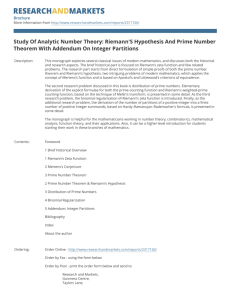Prime number theorem
advertisement
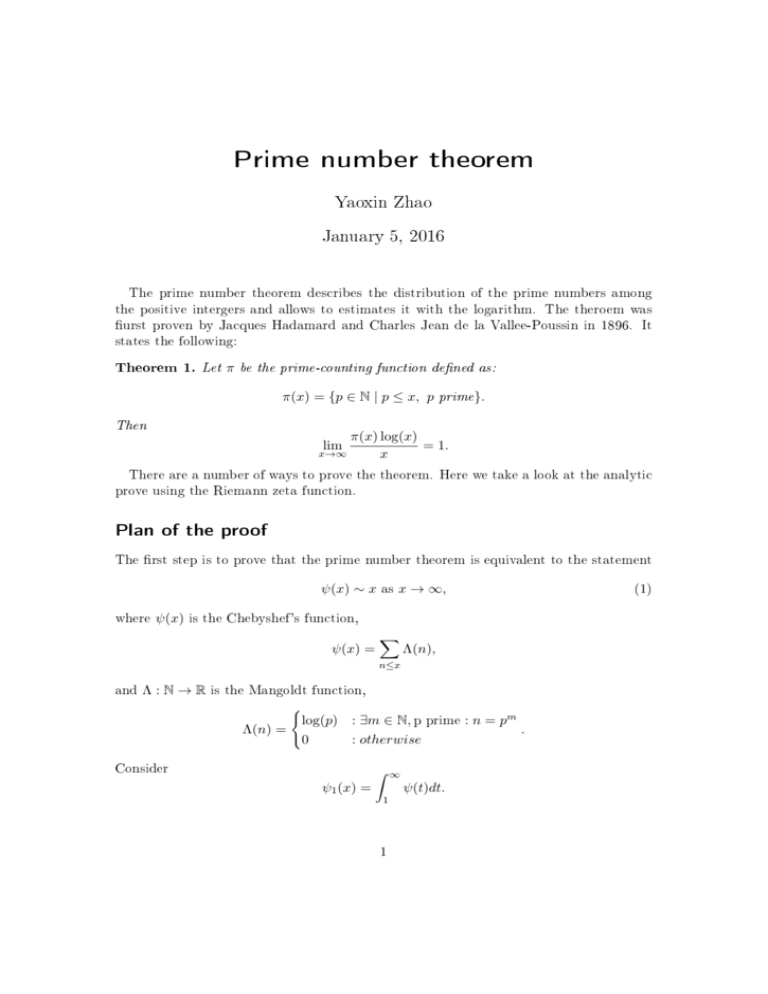
Prime number theorem
Yaoxin Zhao
January 5, 2016
The prime number theorem describes the distribution of the prime numbers among
the positive intergers and allows to estimates it with the logarithm. The theroem was
urst proven by Jacques Hadamard and Charles Jean de la Vallee-Poussin in 1896. It
states the following:
Theorem 1.
Let π be the prime-counting function dened as:
π(x) = {p ∈ N | p ≤ x, p prime}.
Then
lim
x→∞
π(x) log(x)
= 1.
x
There are a number of ways to prove the theorem. Here we take a look at the analytic
prove using the Riemann zeta function.
Plan of the proof
The rst step is to prove that the prime number theorem is equivalent to the statement
ψ(x) ∼ x as x → ∞,
where ψ(x) is the Chebyshef's function,
ψ(x) =
X
Λ(n),
n≤x
and Λ : N → R is the Mangoldt function,
(
log(p) : ∃m ∈ N, p prime : n = pm
Λ(n) =
.
0
: otherwise
Consider
Z
ψ1 (x) =
∞
ψ(t)dt.
1
1
(1)
Now we can show that
1
ψ1 (x) ∼ x2 as x → ∞
2
(2)
implies (1) and then show (2) itself and the theorem is proven. To prove (2) we express
ψ1 (x)/x2 with the Riemann zeta function by means of a contour integral,
ζ 0 (x)
−
ds, where c > 1.
ζ(x)
x−i∞
P
Λ(n)/ns , which is shown in theorem
This is shown by using the identity ζ 0 (s)/ζ(s) = − ∞
n=1
1
ψ1 (x)
=
2
x
2πi
Z
x+i∞
xs−1
s(s + 1)
2.
Since ζ 0 (s)/ζ(s) has a rst order pole at s = 1 with residue 1, we get
ψ1 (x) 1
−
x2
2
With
0
Z x+i∞
1 2
1
xs−1
ζ (x)
1
1−
=
−
ds,
−
x
2πi x−i∞ s(s + 1)
ζ(x)
1−s
1
h(s) =
s(s + 1)
where c > 1.
0
ζ (x)
1
−
−
ζ(x)
1−s
we have
ψ1 (x) 1
−
x2
2
Z x+i∞
1 2
1
xs−1 h(s)ds
1−
=
x
2πi x−i∞
Z
xc−1 ∞
=
h(c + it)eit log(x) dt.
2πi −∞
Now we only need to show that
xc−1
x→∞ 2πi
Z
∞
lim
h(c + it)eit log(x) dt = 0.
−∞
(3)
Showing that the integrant of (3) converges is easily done by applying the RiemannLebesque lemma, but the term xc−1 still tends to innity for c > 1. If we could put c = 1
the term would vanish and the proof would be complete.R The last part of the proof is to
∞
show that we can replace c with 1 and that the integral −∞
| h(1 + it) | dt converges so
riemann-Lebesque is still appliable.
2
Theorem 2.
Let ζ be the Riemann zeta function,
∀s ∈ C : Re(s) > 1 : ζ(s) =
∞
X
1
.
ns
n=1
Then for all s with Re(s) > 1:
∞
X Λ(n)
ζ 0 (s)
=−
.
ζ(s)
ns
n=1
Proof. It is shown by Euler Product that the Riemann zeta function can be written as:
Y
ζ(s) =
p prime
Then we have:
log(ζ(s)) = −
1
.
1 − p−s
X
log(1 − p−s )
p prime
By taking the derivative we get:
X log(p)p−s
ζ 0 (s)
=−
ζ(s)
1 − p−s
p prime
X
1
=−
log(p)
−1
1 − p−s
p prime
X
=−
log(p)
p prime
∞
X
p−ms
m=1
For p prime we have:
∞
X
n:Λ(n)=log(p)
X
Λ(n)
=
log(p)
p−ms
ns
m=1
Then by denition of the Mangoldt function:
∞
X
Λ(n)
n=1
ns
=
X
p prime
and the proof is complete.
3
log(p)
∞
X
m=1
p−ms

